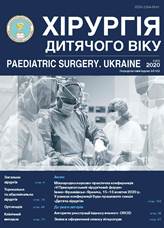Necessity and feasibility of limb length discrepancy correction in congenital vascular malformations in children
DOI:
https://doi.org/10.15574/PS.2020.67.68Keywords:
congenital vascular malformation, limb length discrepancy, surgical treatmentAbstract
Objective: to justify the feasibility and safety of surgical correction of the limb length discrepancy (LLD) in pediatric patients with various forms of congenital vascular malformation (CVM).
Materials and methods. The work is based on the analysis of examination and treatment of 16 patients who were treated at the SI «The Institute of Traumatology and Orthopedics» by NAMS of Ukraine from 2010 to 2019. LLD was established on the basis of clinical and radiological data. Among patients, 12 were treated conservatively; surgical interventions were performed for 4.
Results. LLD was observed in 14 patients due to hypertrophy of the affected limb; due to hypotrophy in 2 patients. Hypertrophy up to 2 cm was in 8 patients; from 2 cm to 3.5 cm was observed in 6 patients. Surgical treatment was used for 4 patients with Klippel–Trenaunay syndrome hypertrophy more than 2 cm; was performed epiphysiodesis with 8-shaped plates. In 3 patients complete LLD correction was achieved in 1.5–2 years, in 1 case the residual LLD of 0.5 cm was preserved. Orthopedic intervention did not affect the course of vascular malformation and did not cause any complications.
Conclusions. It has been established that for patients with CVM the characteristic orthopedic pathology is LLD, which depends on the type of vascular pathology and the age of the patient. The results of surgical treatment of LLD in CVM indicates the feasibility and necessity of surgery in some cases. Surgical treatment of LLD should be justified with due regard for vascular pathology. Epiphysiodesis is a low-trauma and effective way to correct LLD in pediatric patients with CVM.
The research was conducted in accordance with the principles of the Declaration of Helsinki. The research protocol was approved by institution’s the Local Ethics Committee. Informed consent of was obtained from parents of children (or their guardians) for the research.
References
Belov S. (1993). Correction of lower limbs length discrepancy in congenital vascular-bone diseases by vascular surgery performed during childhood. Semin Vasc Surg. 6: 245-251. PMID: 8305979.
Breugem CC, Maas M, Breugem SJ, Schaap GR, van der Horst CV. (2003). Vascular malformations of the lower limb with osseous involvement. J Bone Joint Surg Br. 85(3): 399-405. https://doi.org/10.1302/0301-620X.85B3.13429; PMid:12729117
Dan VN, Sapelkin SV. (2008). Angiodysplasia (congenital malformations of blood vessels). Moscow: Verdana: 200.
Enjolras O, Chapot R, Merland JJ. (2004). Vascular anomalies and the growth of limbs: a review. J Pediatr Orthop. 13: 349–357. https://doi.org/10.1097/01202412-200411000-00001; PMid:15599224
Ferreira MS, Francisco T, Tavares D. (2013). Challenges in orthopaedic management of Parkes-Weber syndrome. BMJ Case Rep. https://doi.org/10.1136/bcr-2013-008800
Hatzokos I, Gigis I, Marinou A, Pournaras J. (2004). Bone lengthening for correction of limb length discrepancy in a patient with Klippel-Trenaunay syndrome. Acta Orthop. Belg. 70: 623-626. https://doi.org/10.1177/230949901101900320; PMid:22184171
Kim YW, Lee SH, Kim DI, Do YS, Lee BB. (2006). Risk factors for leg length discrepancy in patients with congenital vascular malformation. J Vasc Surg. 44(3): 545–553. https://doi.org/10.1016/j.jvs.2006.05.035; PMid:16950432
Lee BB, Laredo J, Lee TS et al. (2007). Terminology and classification of congenital vascular malformations. Phlebology. 22(6): 249–252. https://doi.org/10.1258/026835507782655236; PMid:18274331.
Mattassi R, Vaghi M. (2007). Vascular bone syndrome – angioosteodystrophy: current concepts. Phlebology/Venous Forum R Soc Med. 22(6): 287–90. https://doi.org/10.1258/026835507782655263; PMid:18274337
Schoch JJ, Nguyen JH, Schoch BS, Anderson KR, Stans AA, Driscoll D, Tollefson M. (2019). Orthopaedic diagnoses in patients with Klippel-Trenaunay syndrome. J Child Orthop. 13(5): 457-462. https://doi.org/10.1302/1863-2548.13.190065; PMid:31695812 PMCid:PMC6808075
Takata M, Watanabe K, Matsubara H, Takato K, Nomura I, Tsuchiya H. (2011). Lengthening of the normal tibia in a patient with hemihypertrophy caused by Klippel-Trenaunay-Weber syndrome: a case report. J of Orthоp Surg. 19(3): 359-63. https://doi.org/10.1177/230949901101900320; PMid:22184171.
Downloads
Published
Issue
Section
License
The policy of the Journal “PAEDIATRIC SURGERY. UKRAINE” is compatible with the vast majority of funders' of open access and self-archiving policies. The journal provides immediate open access route being convinced that everyone – not only scientists - can benefit from research results, and publishes articles exclusively under open access distribution, with a Creative Commons Attribution-Noncommercial 4.0 international license(СС BY-NC).
Authors transfer the copyright to the Journal “PAEDIATRIC SURGERY.UKRAINE” when the manuscript is accepted for publication. Authors declare that this manuscript has not been published nor is under simultaneous consideration for publication elsewhere. After publication, the articles become freely available on-line to the public.
Readers have the right to use, distribute, and reproduce articles in any medium, provided the articles and the journal are properly cited.
The use of published materials for commercial purposes is strongly prohibited.

